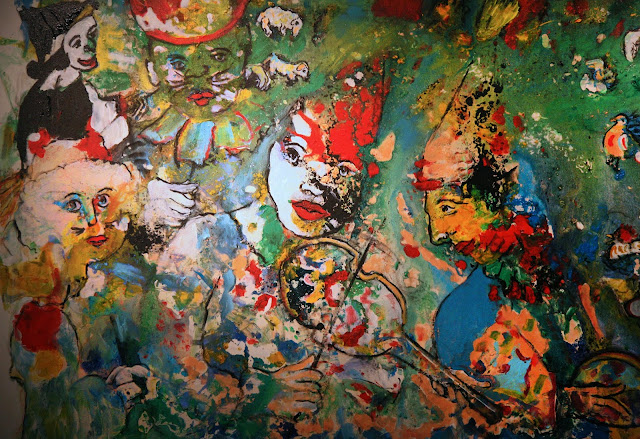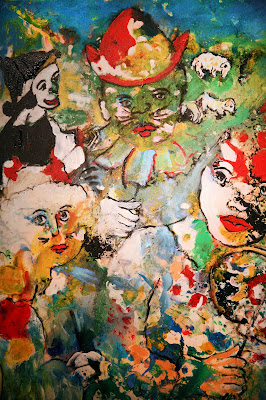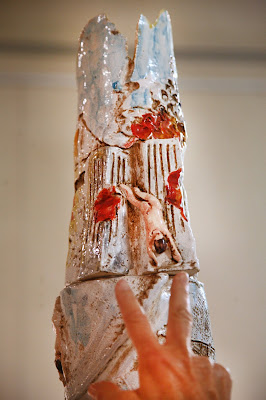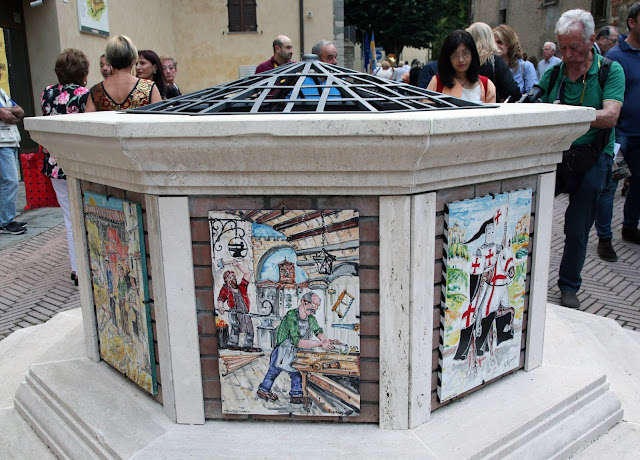Per raccontare la lunga carriera di questo artista occorrerebbero molte ore e libri ponderosi.
Mi limiterò qui ad accennare alle sue mostre ospitate da sedi di altissimo prestigio a Washington, Potsdam, Madrid e Londra oltre che in Italia; citerò soltanto quella del 2014 a Palazzo Medici Riccardi a Firenze e quella appena conclusa nella Sala Vasariana del palazzo della Cancelleria Apostolica Vaticana a Roma, alla quale si riferiscono le immagini della prima parte di questo articolo.
Della sua pittura hanno parlato grandi nomi della critica d'arte come Vittorio Sgarbi e Philippe Daverio, e invitiamo tutti ad accedere al sito web dell'artista per conoscere la sua ricchissima bibliografia, o a sfogliare i suoi splendidi cataloghi.
Sono proprio le sue opere che accolgono gioiosamente lo spettatore nel loro spazio emozionale, uno spazio esuberante e tenero che sa risvegliare in noi la meraviglia dell'infanzia. Personaggi affascinanti si fanno strada nel colore venendo incontro allo spettatore attraverso uno spazio denso di presenze misteriose e fluide. Il loro movimento è dall'invisibile al visibile, dal passato al presente, dal sogno alla realtà, ma senza mai varcarne la soglia. Ne restano sempre al di là, come trattenuti dalle trame del colore, trame anche di storie, di racconti, di poesie.
Fioroni è fedele a un linguaggio che è comprensibile e insieme complesso, pieno di affettività e di rimandi alle favole e al circo dove la fantasia spazia e gioca, dove tutto è familiare e insieme sorprendente.
Se nei lavori su tela colpisce l'avventura e la libertà del colore che si addensa a dare apparente concretezza alle figure e che poi intorno si allarga in trasparenze come vapori e nuvole, nelle ceramiche l'espressività di Fioroni agisce sui volumi, tanto che nei piatti e nelle formelle li evidenzia con tratti che incidono la superficie.
La Torre di Babele diventa la grande metafora del mondo di oggi, con la scala che in un crescendo di solitudine e di violenza la percorre verso la cima dove la ferita delle Torri Gemelle marca l'orrore cui si può giungere.
I Presepi raccontano la storia della Nascita nelle lingue più varie ma sempre fresca e commovente. Nei piatti la bizzarria giocosa di Fioroni trova un altro campo di espressione originale ed estroso.
 |
| (Foto Paolo Ficola) |
 |
| (Foto Paolo Ficola) |
A conclusione di questa prima parte, vorrei citare i due grandi critici che ho menzionato all'inizio: secondo Vittorio Sgarbi Fioroni “è al confine tra reale e irreale, storia e metastoria, dipinto e ceramica, fra astrazione e figurazione. È in questo azzardo continuo, all'interno di una poesia che riscontra la magia nelle cose semplici, che va cercata la radice più autentica dell'arte di Giuseppe Fioroni”.
Philippe Daverio suggerisce che Fioroni riprende il corso della storia dell'arte dalla sospensione che la prima guerra mondiale aveva provocato, e lo avvicina a James Ensor e a Maurice de Vlaminck prima che “il fango delle trincee rendesse cupa la sua tavolozza”; lo accosta “agli arlecchini rosa del primo Picasso e agli svolazzi celesti di Marc Chagall”.
Non si tratta certo di imitazione, ma del riscoprire una freschezza espressiva ricca di evocazioni e di vibrazioni che imprimono alle sue opere un denso e intenso valore poetico.
* * *
Ma Giuseppe Fioroni è noto anche per la generosità e l'amore per la sua terra.
Il suo più recente regalo è un'opera di grande fascino e poesia donata a Mugnano, il paese dei Muri Dipinti tra Perugia e il lago Trasimeno.
Sette formelle in ceramica si incastonano nel pozzo della Piazza del Castello al centro del paese, facendone un gioiello lucido e brillante. Nel realizzarle l'artista ha obbedito al sentimento di affetto che lo lega a Mugnano, paese da lui frequentato tanto tempo fa e del quale ricorda personaggi e amici cari.
Ogni formella è parte di un racconto che suona come un canto epico, alto, dove i personaggi sono protagonisti di una grande avventura spirituale e storica. Questo è vero per i cavalieri rappresentati, ma vale anche per gli artigiani e i contadini. C'è il richiamo a fatti reali ma questi sembrano sognati, prendono forme e colori che la fantasia ha trasformato e cosparso di magia, come nei dipinti medievali dove il mondo sensibile si sublima verso l'astrazione.
Cavalieri di Malta, Templari e monaci Benedettini richiamano la storia di Mugnano e le sue origini e ci proiettano nel mito e nel Medioevo. Il Medioevo è anche e soprattutto una dimensione dello spirito, la possibilità della verità del sogno, la fantasia che trasfigura la realtà. Nel percorrere i vicoli del paese si può sentire che ci sono quei personaggi che nei loro nobili costumi, come numi tutelari, vegliano da una distanza stellare e celeste sulla cinta muraria antica sette secoli e sulle sue torri belle e possenti.
L'arte di Fioroni realizza questa magia perché parla al cuore spingendo l'immaginazione a prendere il volo. Il tempo fermato nelle formelle riprende il suo cammino portando con sé quei valori e quei miti che diventano parte dell'oggi e ne illuminano il senso con richiami ancestrali.
Quella vera di pozzo, proprio come una vera nuziale, sposa due universi, passato e presente, realtà e fantasia, storia e mito, in una gioiosa armonia che l'arte di Fioroni sa creare.
* * *
Giuseppe Fioroni between present, past and dreams
To tell the long career of this artist would take many hours and ponderous books.
I will limit myself here to mentioning his exhibitions hosted by highly prestigious locations in Washington, Potsdam, Madrid and London as well as in Italy; I will mention only the one in 2014 at Palazzo Medici Riccardi in Florence and the one just concluded in the Sala Vasariana of the building of the Vatican Apostolic Chancery in Rome, to which the images of the first part of this article refer.
His works have been described by the great names of art critics such as Vittorio Sgarbi and Philippe Daverio, and we invite everyone to access the artist's website to learn about his rich bibliography, or to leaf through his splendid catalogs.
Why so much interest and so much love? Obviously it can not be just the charm of the character that with the accordion brings back to life tasty Umbrian and Celtic folk traditions, or the sympathy and curiosity that Fioroni raises from the first meeting, or the impression that he is a magician, as Daverio writes .
It is precisely his works that joyfully welcome the spectator in their emotional space, an exuberant and tender space that awakens in us the wonder of childhood. Fascinating characters make their way into color by coming to meet the viewer through a space full of mysterious and fluid presences. Their movement is from the invisible to the visible, from the past to the present, from dream to reality, but without ever crossing its threshold. They always remain beyond it, as if held back by the plots of color, also plots of stories, stories, poems.
Fioroni is faithful to a language that is comprehensible and at the same time complex, full of affection and references to fairy tales and the circus where fantasy spans and plays, where everything is familiar and at the same time surprising.
If in the works on canvas you are srticken by the adventure and the freedom of colours that thicken to give apparent concreteness to the figures and then spread in transparencies like vapor and clouds, in the ceramics the expressiveness of Fioroni acts on the volumes, so that in plates and in panels he highlights them with incisions that affect the surface.
The Tower of Babel becomes the great metaphor of today's world, with the ladder that in a crescendo of loneliness and violence travels it to the top where the wound of the Twin Towers marks the horror that can be reached.
The Cribs tell the story of the Birth in the most varied languages but always fresh and moving. In the dishes Fioroni's playful quirk finds another field of original and fanciful expression.
At the end of this first part, I would like to mention the two great critics I mentioned at the beginning: according to Vittorio Sgarbi, Fioroni " is on the border between real and unreal, history and metahistory, painting and ceramics, between abstraction and figuration. It is in this continuous gamble, within a poem that finds magic in simple things, that the most authentic root of the art of Giuseppe Fioroni should be sought ".
Philippe Daverio suggests that Fioroni takes up the course of art history from the suspension that the First World War had caused, and brings his work close to James Ensor and Maurice de Vlaminck before "the mud of the trenches darkened his palette"; he compares it "to the pink harlequins of the first Picasso and to the celestial flourishes of Marc Chagall".
It is certainly not an imitation, but a rediscovery of an expressive freshness rich in evocations and vibrations that give a dense and intense poetic value to his works.
But Giuseppe Fioroni is also known for his generosity and love for his land.
His most recent gift is a work of great charm and poetry donated to Mugnano, the Village of Painted Walls between Perugia and Lake Trasimeno.
Seven ceramic tiles are set in the well of the Piazza del Castello in the center of the village, making it a shiny and brilliant jewel. In creating them the artist obeyed the feeling of affection that binds him to Mugnano, a village he frequented a long time ago and of which he recalls dear personalities and friends.
Each tile is part of a story that sounds like an epic, high song, where the characters are protagonists of a great spiritual and historical adventure. This is true for the knights represented, but also applies to craftsmen and peasants. There is a reference to real facts but these seem to be dreamed, take shapes and colors that fantasy has transformed and sprinkled with magic, as in medieval paintings where the perceptible world is sublimated towards abstraction.
Knights of Malta, Templars and Benedictine monks recall the history of Mugnano and its origins and project us into myth and the Middle Ages. The Middle Ages are also and above all a dimension of the spirit, the possibility of the truth of dream, fantasy that transfigures reality. As you walk through the narrow streets of the village you can feel that there are those characters who, in their noble costumes, like guardian gods, watch from a stellar and celestial distance on the ancient city walls of seven centuries and on its beautiful and mighty towers.
The art of Fioroni realizes this magic because it speaks to the heart pushing the imagination to take flight. The time stopped in the tiles resumes its journey bringing with it those values and myths that become part of the present and illuminate its meaning with ancestral references.
That true of well, just like a real wedding ring, marries two universes, past and present, reality and fantasy, history and myth, in a joyful harmony that the art of Fioroni can create.






















